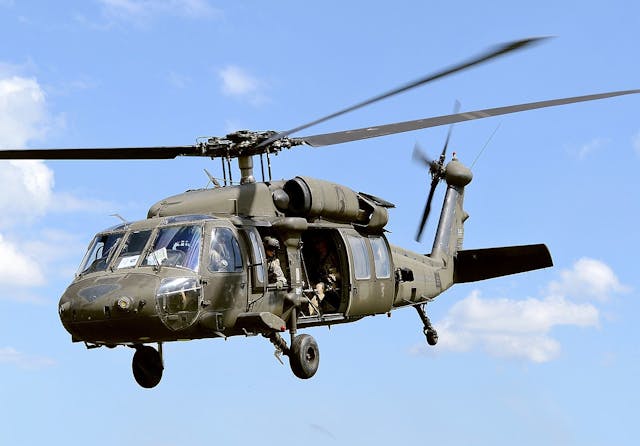Discovering the Thrills and Innovations of the Blackhawk Helicopter
The Blackhawk helicopter stands as a testament to army aeronautics's evolution, combining technical innovations with sensible applications. What lies in advance for this legendary aircraft, and just how will emerging innovations form its future in military operations?
Background of the Blackhawk Helicopter
Considering that its beginning in the 1960s, the Blackhawk helicopter has played a crucial function in modern-day military air travel. Established by Sikorsky Aircraft, the UH-60 Blackhawk was created to fulfill the U.S. Army's requirement for a flexible energy helicopter qualified of performing a variety of goals, including army transportation, medical discharge, and freight airlift. The style was an action to the restrictions of earlier helicopters, especially in regards to maneuverability, survivability, and rate.
The Blackhawk made its very first flight in 1974 and soon entered service in 1979. Its introduction marked a substantial advancement in helicopter technology, featuring a two-rotor system that improved efficiency and security. The airplane's sturdy construction and advanced avionics permitted it to operate effectively in diverse environments and problems.
Throughout the years, the Blackhawk has been continually updated, including lessons gained from various combat circumstances. Its release in disputes such as the Gulf Battle, Somalia, and the Battle on Fear more strengthened its reputation as an important possession. The Blackhawk's legacy is defined by its flexibility and resilience, making it a keystone of army air travel for decades.
Trick Attributes and Specs
The Blackhawk helicopter is distinguished by its robust style and progressed technical attributes, which jointly boost its functional capabilities. Designed mostly for energy objectives, the Blackhawk boasts an optimum departure weight of approximately 22,000 extra pounds, allowing it to lug considerable hauls while maintaining dexterity.
Geared up with 2 General Electric T700-GE-701C engines, the Blackhawk accomplishes a maximum speed of around 183 knots and an array of 368 nautical miles - Blackhawk Helicopter. Its cutting edge blades system includes a four-blade primary blades and a four-blade tail rotor, ensuring stability and maneuverability in numerous flying conditions
The helicopter's cabin can suit as much as 11 soldiers or numerous cargo arrangements, showcasing adaptability in mission profiles. Additionally, the Blackhawk is created with advanced avionics, including digital flight controls and a comprehensive cabin display, improving pilot situational recognition.
For improved survivability, the Blackhawk incorporates ballistic armor and self-sealing gas containers. Its capability to run in diverse settings, from deserts to icy terrains, better strengthens its reputation as a trustworthy system for altruistic and army procedures alike. The Blackhawk's mix of resilience, power, and convenience makes it a keystone of contemporary aerial capacities.
Innovations in Innovation
Developments in innovation have significantly enhanced the capacities of the Blackhawk helicopter, ensuring it remains at the center of military aeronautics. Among one of the most noteworthy advancements is the assimilation of sophisticated avionics systems, which give enhanced situational understanding with real-time information handling and screen. This technology allows look here pilots to browse complicated atmospheres more efficiently, improving goal success prices.

Furthermore, the intro of electronic fly-by-wire systems has revolutionized the control mechanisms of the Blackhawk, providing smoother handling and raised responsiveness. These systems promote sophisticated maneuverability, vital in high-stakes situations. Finally, advancements in interaction and networking modern technologies allow seamless control among devices, boosting general operational effectiveness. Jointly, these technological advancements guarantee that the Blackhawk helicopter remains an essential asset in modern army operations.
Duties in Military Operations
With advanced modern technology enhancing its abilities, the Blackhawk helicopter plays a complex role in armed forces operations. Mostly, it is employed for troop transportation, enabling quick deployment and extraction of workers in numerous combat situations. Its spacious cabin can fit approximately 11 troops, making it a crucial asset for large missions and special procedures.
In Addition, the Blackhawk works as a medevac platform, outfitted to transfer damaged soldiers quickly and effectively from the field of battle to clinical facilities - Blackhawk Helicopter. Its convenience sites extends to logistical support, where it carries supplies and equipment critical for maintaining military procedures in remote locations

The helicopter is additionally important in reconnaissance objectives, offering aerial surveillance and intelligence-gathering capabilities. Its capability to run in diverse atmospheres-- ranging from urban settings to extreme surfaces-- more strengthens its significance on the battleground.
Furthermore, the Blackhawk can be outfitted with innovative weapons, permitting it to engage in battle and offer close air support. This flexibility emphasizes the helicopter's important role in contemporary military strategies, making it an essential part of armed pressures worldwide.
Future Dopes and Innovations
Improvements in technology pledge to usher in a new period for the Blackhawk helicopter, enhancing its capabilities and functional efficiency. Future growths for the Blackhawk may consist of improvements in avionics, such as advanced flight control systems and enhanced situational recognition devices powered by synthetic knowledge.
Moreover, the integration of unmanned systems is on the horizon, possibly enabling manned-unmanned teaming procedures that can expand goal accounts and reduce risk to workers. The Blackhawk's layout is likewise anticipated to integrate lighter and more powerful products, improving fuel performance and general performance.

Verdict
Finally, the Blackhawk helicopter stands for a significant accomplishment in army aviation, defined by its flexibility and advanced technical attributes. Its historical advancement shows a continuous feedback to operational demands, improving capacities in various duties such as army transport and medevac operations. Continuous innovations, consisting of the combination of expert system and hybrid-electric propulsion, promise to additional strengthen the Blackhawk's efficiency and relevance in future armed forces engagements, guaranteeing its standing as a necessary asset on the field of battle.

With innovative technology improving its capacities, the Blackhawk helicopter plays a complex role in armed forces operations. (Blackhawk Helicopter)